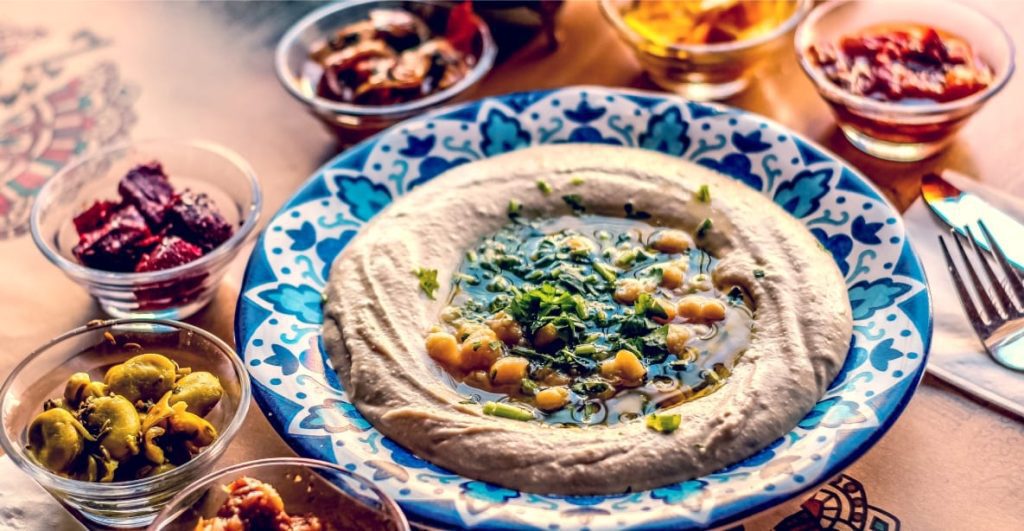Alright then, you toured the entire city of Jerusalem. But what are the Best Restaurants in the Muslim Quarter in Jerusalem? Well here is the ultimate guide to help focus on the top places without sweating too much!
Best Restaurants in the Muslim Quarter: Abu Shukri
A famous hummus that puts an end to the war who is the original Abu Shukri. The place is mostly crowded with tourists and Israelis who come to eat hummus that is considered one of the best in the area. You can all kinds of Hummus; Hummus Msabbaha; Hummus Ful along with the usual toppings of pitas, falafel balls, fries, and salad. It’s located right on the Via Dolorosa at 63 El Wad Rd. Between the 4th and 5th station of the Via Dolorosa that passes through the Muslim Quarter.
Best Restaurants in the Muslim Quarter: Falafel Hidmi
The secret of the freshness of falafel sometimes depends on its location, Falafel Hidmi may be in the heart of the bustle of the Damascus Gate, so sometimes it is impossible to resist the temptation of soft pita, hot falafel balls, and fries that are still sure they are still potatoes in the garden. The great location makes it the leading falafel hole-in-the-wall in the Old City with thousands of pitas a day and happy customers of all kinds, including those who have never seen falafel before. If you have a moment, you can sit and eat on the small chairs, but most take it to go and it is gulped up after a few steps. It’s located just where El Wad Rd. and Beit Habad Rd. connect.
Al Jebrini Tahini (Sheih Reihan 4 St,. Near Damascus Gate)
If you’ve ever wondered what a real traditional tahini factory looks like, take a look around. An ancient workshop with several handmade machines, and in the center on the floor there is a large sheet of cloth topped with sesame hills for the famous Jerusalem Bagel. Now the brothers produce tahini in the traditional method: it is the time of roasting the sesame seeds that determines the color of the grain.
So does the color of the tahini. If the grains are roasted for a while, they will remain white and make light tahini from them. Grains that have been weighed for many hours subsequently turn red and from them produce red tahini. Despite the high calories and fat percentages, tahini contains calcium, iron, and omega 3, which are very important for the daily menu! Visits must be arranged in advance, so please call Ishak on (00)972(0)52-2324224
Behind the local grocery store of the brothers, Ishak and Zechariah Jebrini hides a family business and a whole and fascinating story. The Jebrini family’s tahini factory has been producing fresh and natural tahini without baking soda, lime or other bleaches for 135 years and with the same millstone! The brothers of the Jebrini clan were the only ones in the family who decided to continue the tahini production tradition.

THAT TAHINI CAN WORK WONDERFULLY ON A NICE CRACKER WHILE TOURING JERUSALEM
The sesame that undergoes a long process is roasted in an Arabian stone oven for several hours. Depending on the time of roasting, the tahini will come out – white or red. The place also produces tahini made of blackened nutmeg. My personal favorite dish to eat there is the fresh Halva! Especially in the cold winters of Jerusalem. Or poor their tahini to your Hummus and it’s like hocus-pocus on your Hummus dish.
Arafat Hummus (Hummus Nazmi) David St & Shuk Haturfim
During the Crusader period, there was a real change in the appearance of the markets of the old town Jerusalem, when the Crusader queen Melisanda, Queen of Jerusalem divided the western half of the wide cardo into three parallel narrow markets and added a stylish roof to each market. She devoted a percentage of the store profits to Santa Ana Convent where her younger sister Agnes stayed.

MAKLUBA – THE TRADITIONAL PALESTINIAN DISH
This array of markets is the array that exists to this day, in the streets called “Spice Market”, “Butchers Market” and “Goldsmiths Market”. In some markets, you can still see the SA letters engraved on the vaults, which indicate the monastery above. In one of these markets, there is a delicious Hummus joint called Arafat Hummus! If you won’t grab a seat visitors will grab the last available table in the dining space. Then the waiter will reveal the well-kept secret for 65 years now that every day at 12:30 pm the owners turn their daily makluba pot, whose name has spread far and wide.
The Ultimate Kebab in Old Town Jerusalem – Kebab Al Shaab!
The place itself is tiny and the grill on which the kebabs are roasted is the miracle of creation that works contrary to all the rules of grilling, because it is located inside a niche hewn in an ancient stone wall, next to the entrance door to the place. Each kebab is grilled here skewered on giant stainless steel shish kebabs – and for just a few minutes – over a live fire. No fries, no tahini, no salads. The kebab is served only with tomatoes and onions burnt on the fire, and those who want are invited to eat in the Ottoman Turkish style and pour on the kebab a mound of cold yogurt coming from Hebron dairies. Adress: Shuk HaBsamim Old City Jerusalem.






